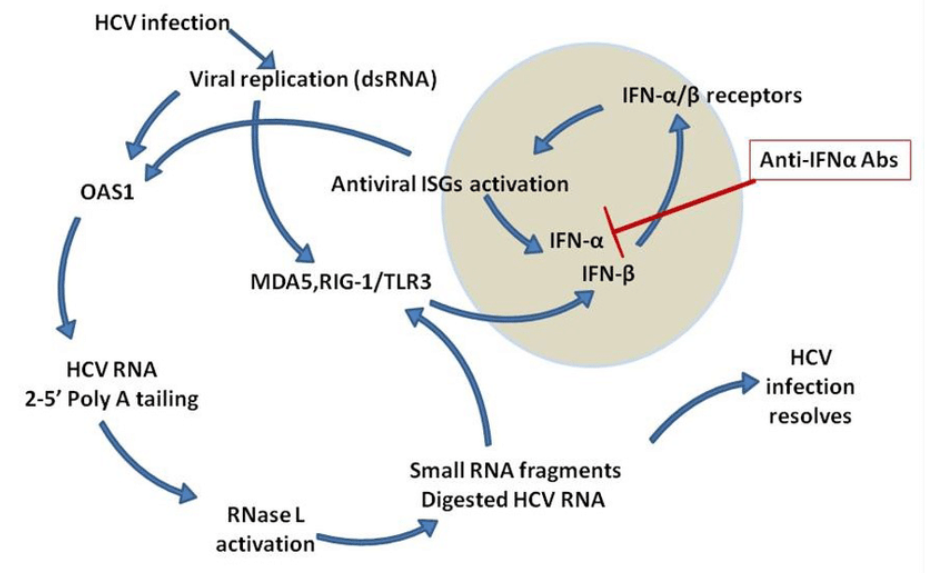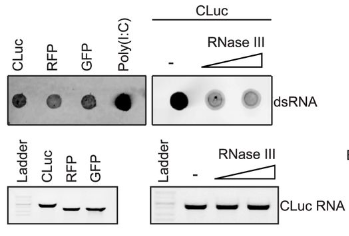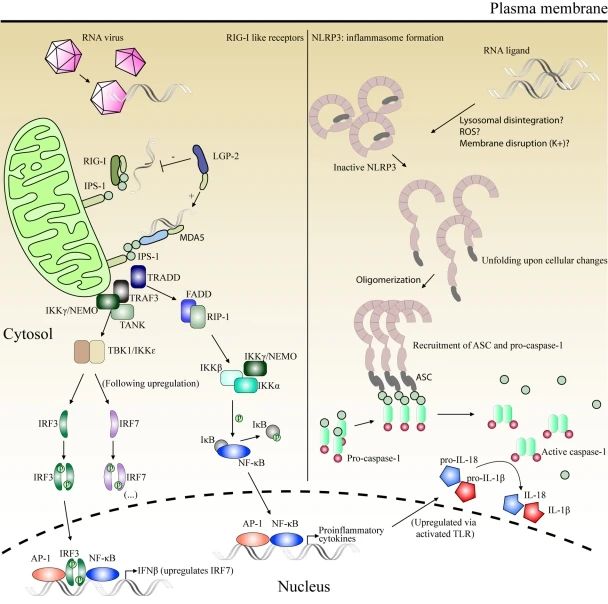dsRNA | A Hallmark of Viral Infection

Recent Advances
dsRNA (double-stranded RNA) consists of two complementary nucleotide strands paired through base pairing. It plays a critical role in regulating gene expression, activating immune responses, and RNA interference technology. dsRNA also serves as the genetic material for certain viruses and can trigger the innate immune response of host cells.
Mechanisms of dsRNA Formation
-
First Mechanism:
T7 RNA polymerase (T7 RNAP) possesses RNA-dependent RNA polymerase (RdRp) activity, enabling it to use the product RNA as a template to extend the 3' end of the RNA, forming a hairpin structure through reverse complementarity with the original RNA molecule. Alternatively, during transcription, randomly fragmented or incomplete transcription products can pair with mRNA and extend to form incomplete dsRNA. -
Second Mechanism:
dsRNA can be formed through transcription of the DNA antisense strand, independent of the promoter.

Figure 1: Schematic Diagram of dsRNA Replication
Classic dsRNA Clones
-
J2 Clone:
The J2 monoclonal antibody (Anti-dsRNA mAb J2) is the gold standard for dsRNA detection, known for its high specificity. Initially used in plant virus research, J2 has been widely adopted since Weber et al.'s seminal paper in 2006 to demonstrate the abundant dsRNA produced by all positive-sense RNA viruses in infected cells. -
K2 Clone:
The K2 monoclonal antibody (Anti-dsRNA mAb K2) is another anti-dsRNA monoclonal antibody, primarily used in ELISA and sandwich ELISA assays. K2 excels in accurately identifying dsRNA even in high-background environments, particularly under conditions of high L-dsRNA concentration and prolonged incubation, demonstrating the strongest binding affinity for native dsRNA.
Biological Significance of dsRNA
-
dsRNA as a Marker of Viral Infection:
dsRNA is often regarded as a hallmark of viral infection, as many viruses (especially double-stranded RNA viruses) use dsRNA as their genome or replication intermediates. For example, positive-sense RNA viruses (+ssRNA) synthesize negative-sense RNA (-ssRNA) during replication, forming dsRNA, which is then used to produce more positive-sense RNA.

Figure 2: dsRNA produced after viral infection is recognized by receptors such as RIG-I, MDA5, and TLR3, triggering the production of IFN-β and activating ISGs, including OAS and IFN-α, forming a positive feedback loop for antiviral responses. Anti-IFN-α antibodies neutralize IFN-α, inhibiting ISG induction, weakening the immune response, and affecting viral clearance.
-
dsRNA in mRNA Vaccines and Therapeutics:
In mRNA vaccines and therapeutics, dsRNA is a byproduct generated during in vitro transcription (IVT) of mRNA. It can be recognized by intracellular nucleic acid receptors such as TLR3, MDA5, or RIG-I, triggering innate immune inflammatory responses.

Figure 3: Formation of 3'-extended RNA byproducts during IVT reactions. (A) dsRNA detection using the dsRNA-specific antibody (J2) for three different mRNA sequences (CLuc, RFP, and GFP).
-
dsRNA in Immune Signaling Pathways:
As an important pathogen-associated molecular pattern (PAMP), dsRNA activates key receptors in the innate immune system (e.g., RIG-I, MDA5, and TLR3). These receptors recognize dsRNA, inducing the production of antiviral molecules such as interferons (IFN), thereby triggering a robust immune response.
Upon binding dsRNA, NLRP1 releases its UPA and CARD domains, assembling inflamma some seeds that induce inflammasome formation and activate caspase 1. Activated caspase 1 cleaves pro-inflammatory cytokines (e.g., IL-1β and IL-18) and the pore-forming protein gasdermin D (GSDMD). GSDMD pores form in the plasma membrane, inducing pyroptosis, an inflammatory form of cell death.

Figure 4: dsRNA acts as a molecular pattern recognized by RIG-I (Retinoic Acid-Inducible Gene I) and MDA5 (Melanoma Differentiation-Associated Protein 5), initiating innate immune responses.
Conclusion
dsRNA plays a pivotal role in understanding viral infection mechanisms and host immune responses, as well as in developing new antiviral strategies and vaccine technologies. Through in-depth research on the formation mechanisms of dsRNA, its recognition by receptors, and its role in immune activation, scientists can better understand how viruses evade or manipulate the host's innate immune response and design more effective vaccines and therapeutics to combat viral infections.
Advantages of Rabbit Monoclonal Antibodies
Starter offers anti-dsRNA antibodies, including the classic J2 and K2 clones, known for their high batch-to-batch consistency and sensitivity. Additionally, we provide a range of high-purity, high-activity proteins, delivering premium-quality antibodies and proteins to our customers.
Product Information
| Gatalog Num | Product Name | Product Parameters | Price |
| UA070036 | DNase Ⅰ | Host : Bovine Pancreatic | $91 |
| Expression System : E.coli | |||
| Conjugation : Unconjugated | |||
| UA070038 | Pyrophosphatase, Inorganic | Host : Yeast | $47.20 |
| Expression System : E.coli | |||
| Conjugation : Unconjugated | |||
| UA070037 | Murine RNase Inhibitor | Host : Rat | $40 |
| Expression System : E.coli | |||
| Conjugation : Unconjugated | |||
| UA070035 | BsaⅠ | Host : Bacillus stearothermophilus | $36 |
| Expression System : E.coli | |||
| Conjugation : Unconjugated | |||
| UA070046 | RNase Ⅲ | Conjugation : Unconjugated | $76 |
| S0B0985 | dsRNA Recombinant Mouse mAb(K2) | Host : Mouse | Inquiry |
| Conjugation : Unconjugated | |||
| S0B0659 | dsRNA Recombinant Mouse mAb (J2) | Host : Mouse | $420 |
| Conjugation : Unconjugated |




